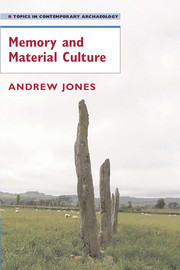Book contents
- Frontmatter
- Contents
- Preface
- 1 Memory and Material Culture?
- 2 From Memory to Commemoration
- 3 People, Time, and Remembrance
- 4 Improvising Culture
- 5 Continuous Houses, Perpetual Places: Commemoration and the Lives of Neolithic Houses
- 6 Culture, Citation, and Categorisation: Regionality in Late Neolithic Britain and Ireland
- 7 Chains of Memory: The Aesthetics of Memory in Bronze Age Britain
- 8 The Art of Memory: Memory, Inscription, and Place
- 9 Tracing the Past: Landscape, Lines, and Places
- 10 Coda
- References
- Index
9 - Tracing the Past: Landscape, Lines, and Places
Published online by Cambridge University Press: 07 December 2009
- Frontmatter
- Contents
- Preface
- 1 Memory and Material Culture?
- 2 From Memory to Commemoration
- 3 People, Time, and Remembrance
- 4 Improvising Culture
- 5 Continuous Houses, Perpetual Places: Commemoration and the Lives of Neolithic Houses
- 6 Culture, Citation, and Categorisation: Regionality in Late Neolithic Britain and Ireland
- 7 Chains of Memory: The Aesthetics of Memory in Bronze Age Britain
- 8 The Art of Memory: Memory, Inscription, and Place
- 9 Tracing the Past: Landscape, Lines, and Places
- 10 Coda
- References
- Index
Summary
In Chapter 8, I discussed the role of art or inscription as a mnemonic for place. In the case of Irish passage tombs distant places were referenced by incorporating materials into monuments or by the deposition of stone. The significance of place was made reference to by the repetitive embellishment of the interior of tombs. In this chapter I again want to consider the relationship amongst inscription, place, and remembrance. I do this by considering the case of prehistoric rock art placed in open air landscape settings. How images in the landscape resonate with the landscape around them is an important topic of archaeological and philosophical enquiry (see Heyd 2005). Open air rock art differs from Irish passage tomb art because it does not simply refer to place but is ‘in’ place. We examine the ways in which rock art depictions bring into focus different understandings of ‘place’ in landscapes. What is the relationship between rock art and ‘place’, and to what extent is such a relationship the product of memory? Is rock art in fact a form of ‘writing without words’?
I want to consider these issues by thinking about the materiality of memory in more depth. As I indicated earlier, there is an intellectual problem in tacitly treating inscription as a form of memory storage. The claim that writing or inscription acts as a means of storing memory takes no account of the medium on which inscription takes place.
- Type
- Chapter
- Information
- Memory and Material Culture , pp. 190 - 222Publisher: Cambridge University PressPrint publication year: 2007



